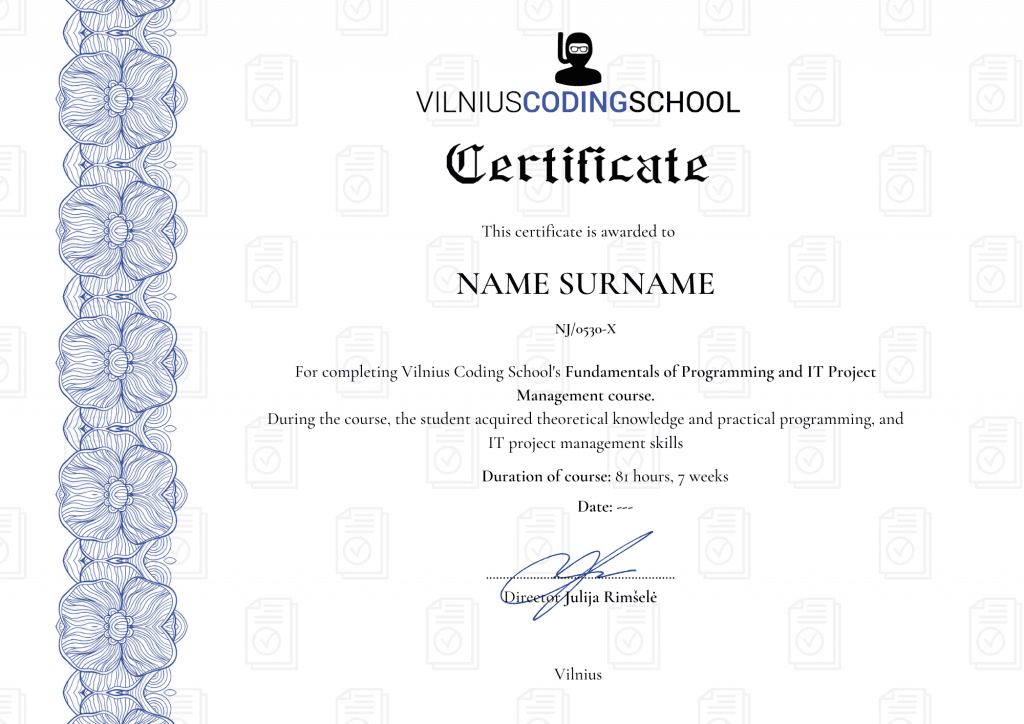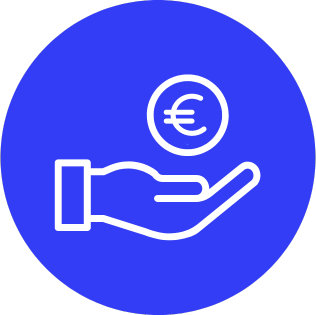Planned training:
May 13
June 7
July 8
August 12
September 9
October 7
November 4
December 2
Price:
3950€
Funded by the Employment Service
![]()
![]()
![]()
![]()
![]()
Data science with Python is a field that uses the toolkit of the Python programming language ecosystem to derive meaningful insights from data. Python provides a powerful bibli...
What after training?
After these trainings, students are invited to continue participating in the school's mentoring program free of charge: for a whole month, if questions arise, they can both contact the school's lecturer and use the school's classrooms for independent study.
For our students who want to start a career in the IT field, the Career Center will help them search for an internship or job, provide all the necessary information about job interviews, help them prepare a strong and attractive CV and LinkedIn profile, which will distinguish you from other candidates during the selection process. We constantly share job and internship offers and advise on all issues related to employment. You will not be alone during your job search, our professional team of consultants and mentors will provide comprehensive assistance to achieve your goal of successfully starting a career in the IT field.
Vilnius Coding School cooperates with more than 250 companies - partners that can provide career opportunities for graduates of our school. Even 85 percent everyone who has finished school and applied for a job is successfully employed.
Training program
- History of the Python language
- Setting up the programming environment
- Variables and their types; If, elif, else clauses
- Operators and Mathematical Operations
- The structure of the for loop
- Iterating through lists and dictionaries
- Range function and cycle control
- Break and Continue commands in a for loop
- While loop structure
- Checking conditions in a while loop
- Structure and definition of functions
- Recursion and its application
- Understanding variable areas (scope)
- Executing scripts and passing parameters on the command line
- Python Package Management (pip)
- Exceptions and file handling in Python
- Reading and writing a text file
- File manipulation
- Python Getting a list of files and directories
- Reading and writing cases with Python
- JSON data format
- Lists, dictionaries and their use
- Code organization and packaging
- What is Git and why use it?
- Git vs. other version control systems
- Git installation instructions
- Initial configuration of Git
- Working with local repository: Init, Add, Commit, Status, Branching, Switching: Branch, Checkout
- History View and Diff: Log, Diff
- What is a remote repository?
- Remote, Clone, Push, Pull; Merge and Rebase: How to Merge Jobs
- Conflict resolution
- Security practices: SSH keys
- Git flow models: Gitflow, GitHub flow
- Git GUI clients and tools
- Concepts of object, class and methods
- Classes and objects
- Class declaration and structure
- The role of constructors and destructors
- Creating object instances
- Initializing variables
- Calling methods through objects
- Class-Object Interaction
- Concept and use of inheritance
- Parent and child classes
- Principles of polymorphism
- The essence of polymorphism
- Creating abstract classes
- Data management and transformation
- Creating and using data models
- Project: Application of object-oriented programming in data science
- Real data analysis situations
- Storing data and state in class objects
- Storing variables and properties
- State management through objects
- Class Methods and Properties: Static properties and methods
- Using class methods
- Class-Object Interaction
- Object interaction scripts
- A data analysis project with OOP principles
- Data management and transformation using objects;
- Using objects to transform data;
- What is web scraping and its benefits
- HTML Basics
- Sending HTTP requests and analyzing responses
- Legal restrictions and ethical issues in web scraping
- BeautifulSoup and other web scraping libraries
- Installing and Introducing the BeautifulSoup Library
- Finding and extracting elements from an HTML page
- Using scraping rules and templates
- Pandas library presentation
- Data filtering and grouping
- Data visualization with Pandas
- Data Structures: Series and Data Tables (DataFrame)
- Processing unbalanced data
- Textual data analysis and processing
- Text data management
- Text analysis methods
- Examples of text data with Pandas
- Visual data analysis and processing
- Image data loading and processing
- Image processing libraries (OpenCV, Pillow)
- Image visualization
- An overview of the importance and basic principles of testing:
- Different types of testing such as black box, white box, and gray box
- The Importance of Unit Tests in the OOP Context: The benefits of unit tests in the object-oriented programming paradigm
- Writing Test Cases for Classes and Methods: Practical examples of developing test scenarios
- In Mocking and Patching Unit Tests
- TDD Applying OOP with Python
- Using PyTest to Test Classes
- OOP Testing Best Practices
- Testing frameworks: A comparison of PyTest, unittest, nose2, and other tools
- Test Automation: Application of automated testing tools
- Test cases with databases
- Testing of data flows and services
- Testing metrics
- Practical Testing: Project
- Extracting data from a database with Python
- Database Interfaces with Python
- Real data mining projects
- Data transformation, management and analysis with SQL and Python:
- Data transformation and management methods
- Data analysis tools and libraries
- Practical examples of data analysis
- Data storage, retrieval and indexing:
- Data retention policies
- Principles of database indexing
- The origin and significance of clustering in data science
- Types of clustering algorithms: hierarchical, K-means, DBSCAN
- Deepening the K-Means Clustering Algorithm
- Principles of hierarchical clustering
- Model training, evaluation, and hyperparameterization: Principles of model training
- Model evaluation: accuracy, sensitivity, specificity
- ROC and AUC analysis
- Hyperparameter Optimization: Grid Search and Other Methods
- Interpreting models and using interpretable models
- Time series and forecasting
- Supervised Machine Learning:
- Decision Trees, Random Forests
- Concept and application of Random Forests
- Algorithms for unsupervised learning
- Modeling Decision Trees and Random Forests
- Introduction to K-Nearest Neighbors (k-NN) and Naive Bayes classification
- The essence and application of k-Nearest Neighbors (k-NN) algorithm
- Principles of Naive Bayes classification and understanding of Bayes theorem
- k-NN and Naive Bayes model development
- Regression Analysis and Regression Models:
- Basics of regression analysis and different types of regression
- Linear Regression and Polynomial Regression
- Regression model development and regression analysis
- Building a machine learning model
- Data collection and preparation for the project
- Model development and training
- The beginnings of neural networks and biological inspiration
- Perceptron and network architectures
- CNN architectures and their application in image analysis
- Generative models of artificial intelligence (AI).
- Principles of recurrent neural networks
- LSTM and GRU networks for text analysis
- Using RNNs in text and sequence generation
- Model estimation methods:
- Assessment of model accuracy (Accuracy).
- Assessment of model accuracy and accuracy
- Assessment of model recall and F1 points
- Model development and training with deep networks
- Model evaluation and optimization
- Natural Language Processing (NLP)
- Text data mining and management
- Language models and text classification
- Topic modeling and language generation techniques
- Hyperparameter optimization
- Hyperparameter selection strategies
- Model interpretation methods
- Design initiation and data collection
- Design initiation principles and task definition
- Data collection strategies and sources
- Data analysis methodology and data management
- Machine learning model development and network architecture
- Model evaluation, performance metrics and refinement
- Model presentation strategies and effective communication
- Documentation and analysis of results
- Selection and definition of projects:
- Selection of topics and projects
- Project definition, objectives and requirements
- Data collection and preparation:
- Identification of data sources and data collection
- Data management, transformation and cleaning
- Model development and training:
- Model structure design
- Data training process and model development
- Model estimation and hyperparameter determination
1. Communication skills
- Active listening
- Effective communication
- Dealing with difficult customers
- Creating a connection
2. Problem solving strategies
- Problem analysis and diagnostics
- Determination of solutions
- Troubleshooting methods
- Root cause analysis of the problem
- Latest problem solving technologies
- How to get feedback from managers
- Professional development
3. Time management and organization
- Prioritization of tasks
- Workload management
- Delegation and collaboration
4. Emotional intelligence
- Understanding and managing emotions
- Empathy and compassion
- Conflict resolution
- Stress management
5. How to learn more and faster and less
to forget
- 5 minute brain exercise
- Clear your "mental fog" with these 5
delicious brain foods - Learn a powerful memory technique to
you would never miss a meeting
Vilnius coding School CERTIFICATE
strong evidence that you are ready career ITEM!

Official certificate approved by the Education and Science Register
Recognized by the strongest Lithuanian and international companies
It proves that you have studied with the best specialists in your field
Reliable proof of acquired skills
Certificate issued by a company developing transparent activities in Lithuania
This certificate confirms that you attended at least 95% of the course lectures in real time with the lecturer, completed and defended the final thesis





